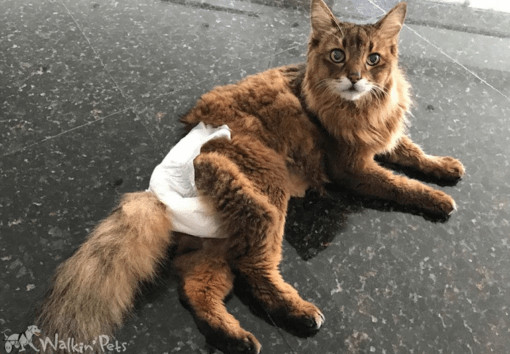Incontinence in cats, while often associated with older or unwell felines, is a surprisingly common issue that can stem from various causes, including obesity and bladder stones. Regardless of the root cause, dealing with a cat experiencing incontinence can be challenging for both you and your beloved pet. Fortunately, solutions exist, and one of the most effective is using nappies for cats.
It’s crucial to understand that even with the use of cat nappies, regularly assisting your cat to empty their bladder, known as bladder expression, remains essential. This should be done approximately every eight hours to prevent infections, a concern that nappies alone cannot address. For the best comfort and hygiene for your cat, nappies and bladder expression should be considered complementary practices.
 Cat wearing a nappy
Cat wearing a nappy
Like any pet care solution, cat nappies come with their own set of advantages and disadvantages. Before delving into these considerations, it’s helpful to understand the different types of nappies available for your feline companion.
Types of Cat Nappies
When choosing nappies for your cat, you’ll generally find three main types:
Disposable Cat Nappies
Similar in concept to baby diapers, disposable cat nappies are designed for single use. Their appeal lies in their convenience – they are typically adjustable and can be simply discarded after use, eliminating the need for washing. However, the ongoing cost of disposable nappies can accumulate over time.
Cloth Cat Nappies
For a more eco-conscious and potentially gentler option, cloth cat nappies are available. These washable nappies are softer against your cat’s skin, which can enhance comfort. However, they may require a bit more effort to fit correctly, and regular washing is necessary to maintain hygiene and prevent skin irritation.
Wrap Cat Nappies
Wrap nappies are specifically designed for urinary incontinence and do not cover the entire bottom area. They offer a less restrictive and potentially more comfortable fit for cats. However, their functionality is limited to urine leakage and are not suitable if your cat also experiences bowel incontinence.
The Benefits of Using Cat Nappies
The advantages of using nappies for cats are numerous and impactful, significantly improving both your cat’s well-being and your home environment. Primarily, cat nappies prevent messes throughout your house, which can save your cat from embarrassment and reduce your cleaning workload considerably. They also empower your cat to regain a sense of independence, allowing them to urinate more comfortably and frequently, which can be crucial in preventing urinary tract infections.
For cats with mobility challenges, particularly those with weakened hind legs, nappies are exceptionally beneficial. These cats often scoot or drag themselves, and nappies provide a protective layer that prevents painful rug burn and skin irritation.
Furthermore, for cats that scoot, nappies act as a vital barrier against bacteria on the floor, preventing bacteria from entering the urethra and causing urinary tract infections (UTIs). UTIs can exacerbate incontinence issues and cause further discomfort, making nappies a proactive solution for prevention.
Beyond incontinence, cat nappies can also be a helpful training tool for cats that spray or mark their territory, discouraging this behaviour by containing the urine and disrupting the marking habit.
The Drawbacks of Using Cat Nappies
While cat nappies offer significant benefits, it’s important to acknowledge potential downsides. One common challenge is getting your cat to cooperate with wearing a nappy. Some cats can be resistant, making the process of putting on or changing a nappy difficult. Patience and a gentle approach are key when handling your cat during nappy changes.
How to Change a Cat Nappy
Changing a cat nappy can be straightforward with a calm and gentle approach:
- Hold your cat securely, similar to cradling a baby. Gently slide their tail through the designated tail hole in the nappy.
- Bring the wider part of the nappy between their hind legs and under their abdomen.
- Position the shorter side over their back and fasten both sides together using the closures provided with the nappy (these may be hooks, clips, or adhesive tabs). Avoid restraining your cat forcefully or using excessive pressure.
- For cats with long tails or those with limb fusions, adjusting the nappy sideways may provide better coverage and maintain comfort.
It’s important to note that not all cats readily accept wearing nappies. Some may find them irritating initially and require time to adjust. Experimenting with different types, such as disposable versus cloth, and trying various brands can help you find the most suitable and comfortable option for your cat.
Additional Considerations for Cat Nappy Use
One of the most persistent challenges can be keeping the nappy securely in place. Initially, some cats may attempt to remove the nappy by wiggling, scratching, or biting at it. Remember that cats are naturally sensitive creatures and may be unaccustomed to wearing anything, especially something wrapped around their body.
Using Baby Onesies to Secure Cat Nappies
If your cat persistently tries to remove their nappy, consider using a baby onesie. While it might seem unusual, it can be surprisingly effective. Dressing your cat in a onesie over the nappy prevents them from reaching and removing it. The onesie also aids in holding the nappy in place, preventing slippage due to movement. Since onesies can get soiled, having a supply of backups is advisable.
Caring for an incontinent cat with nappies and onesies may at times feel akin to caring for a baby again. However, despite the learning curve and adjustments involved, cat nappies remain one of the most practical and compassionate solutions for managing feline incontinence. They are readily available, relatively easy to use, and with patience, both you and your cat can adapt to this routine, ultimately improving your shared quality of life.
If nappies aren’t the right solution for your situation, exploring options like a self-cleaning litter box can also be beneficial in managing cat hygiene and minimizing mess.
Guest post adapted from content by Ellie Batchiyska of Handicapped Pets, a trusted resource for pet mobility aids and support products.
